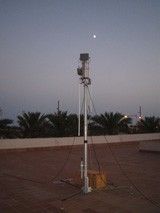
-
StatusCompleted
-
Status date2014-12-09
The ESA Telecom Start-up Project STICK aims at providing broadband communications capabilities to the Public Protection and Disaster Relief sector.
Once operational, STICK will be a service that can be easily deployed by minimally trained operators, providing a mobile broadband shared network that can be simultaneously accessed by multiple users with multiple applications fully independent from availability of public networks which may collapse when disaster strikes, although it will take advantage of them if they are available to provide lower cost reach-back links to the operations command and control centre.
STICK will deliver scalable on-demand communication capabilities, in the form of broadband wireless access to deployed and roaming subscribers, through a common satellite communications reach-back into the static network. Satcom capacity will be distributed through multi-hop linear topologies of multiple scattered nodes, blanketing any area of emergency relief operations, and operating over unlicensed frequency bands (2.4 GHz and 5 GHz).
The main issue which this project addresses is the difficulty of providing a communications infrastructure that suits to the needs of emergency response teams on the field:
- Easily and quickly deployable by non-expert personnel (firemen, policemen, etc),
- Secure and resilient, even if conventional networks collapse under a major crisis,
- Smart distribution and aggregation of satcom capacity in the incident area (shift bandwidth available on several satellite connections to users on demand),
- End-to-end secure data, VoIP, streaming video services,
- Economically viable, given that there are terrestrial alternatives to these needs, although their coverage and resilience do not fulfil all the requirements of emergency response teams. For this reason, other uses for STICK are being actively sought to achieve a critical mass that makes possible for this start-up to succeed.
The business opportunity lies in providing an integrated satellite-terrestrial alternative to the disparate media-mix of today?s emergency management, hazards and disaster-relief civil protection agencies and independent emergency relief groups (e.g. NGOs). The key commercial aspect is the small form factor and modular approach from a hardware point of view, and the self-forming, self-managed and highly scalable nature of the deployable satellite-terrestrial backbone and access networks, from a service provision point of view.
Today, DREM workers rely upon unconnected and very heterogeneous bearers, like Iridium, Globalstar and Inmarsat phones, scattered 802.11 access points with satellite broadband reach backs, trunking digital radio networks (e.g. TETRA, P25 in the U.S), two-way handheld VHF radios, and standalone fly-away satellite terminals. Besides the problems associated to deploying these stove-piped systems separately, there are the obvious interoperability and management burden issues, as well as the limited reach, and the inefficient use of the very expensive satellite bandwidth.
STICK network nodes connect to each other over wireless point-to-point or point-to-multipoint line-of-sight (LOS) bridges, over one or more hops. The bridges will follow the LOS contours of the incident area, creating an Incident Area Network (IAN). All nodes will have IP-based satellite access to some degree, through different terminals sizes, access schema, and access rates. Wideband and broadband satellite access, via BGAN and DVB-RCS respectively, will be used for backhauling into the static network. Narrowband, always-on satellite access over BGAN will primarily be used for network management purposes.
Once deployed and turned on, STICK Nodes will contact the Network Management Centre using the management satellite link to first report their precise GPS/Galileo location, and in response receive configuration templates from a central network management expert system. Those templates will drive the mobile routers in each node to configure themselves to build the network and point their antennas to adjacent nodes. Routers will establish adjacencies that will create the IAN fabric. Once connected to the IAN, the routers will join a secure VPN, on which all fixed DREM information services will operate.
These autonomous communications nodes will actually look like "sticks", i.e. rod-like assemblies about 50 to 70 centimetres long, encompassing a mobile router, 802.11 radios for providing WiFi coverage to clients around each STICK and also for inter-STICK links using directional antennas, wireless bridges, and a BGAN Class-3 small-size terminal providing the network management reach back. The internal STICK electronics will be protected by a rugged cylindrical enclosure. Attached to the enclosure one will find two flat panel antennas placed at different heights. These antennas will be steerable in azimuth by stepper motors controlled from the remote NMS, through the router inside the STICK.
STICK development and trials have a scheduled time-span of 18 months from the start of the project (December 2006). The main phases of the project are:
- Design Specification (Dec 06-Mar 07): Functional and Technical Specification,
- Design and Development (Mar 07-Dec 07): Test bed integration, development of all software modules, Functional Acceptance Test,
- Integration and Deployment (Mar 07-Jun 08): System Integration, Manufacturing of 3 STICKs, Functional and Performance Testing,
- Validation and Field Trials (Oct 08-Nov 08): Field trials with end users,
- Business development (Oct 08-Dec 08): Refining the Business Plan for STICK and gathering interest from potential customers.
The design, development and manufacturing of the three STICKs has been performed satisfactorily. The 3 STICKs prototypes have been validated and presented to ESA at the mid-term review (September 2007).
We are currently preparing the trials with the Catalonian firemen that should take place in november 2008. We are also presenting the STICK product to other potential customers. The following figure depicts the STICK prototype being tested on GTD roof. We can appreciate the planar antennae that can communicate with adjacent STICKs up to 3 km away, as well as the omnidirectional antennae that provide wifi coverage to users around the STICK.
We are also evaluating the extension of the product to cover new requirements from the users. We may also develop a “Stick-on-the move” that can be installed on a vehicle and can be used while the vehicle is moving.






